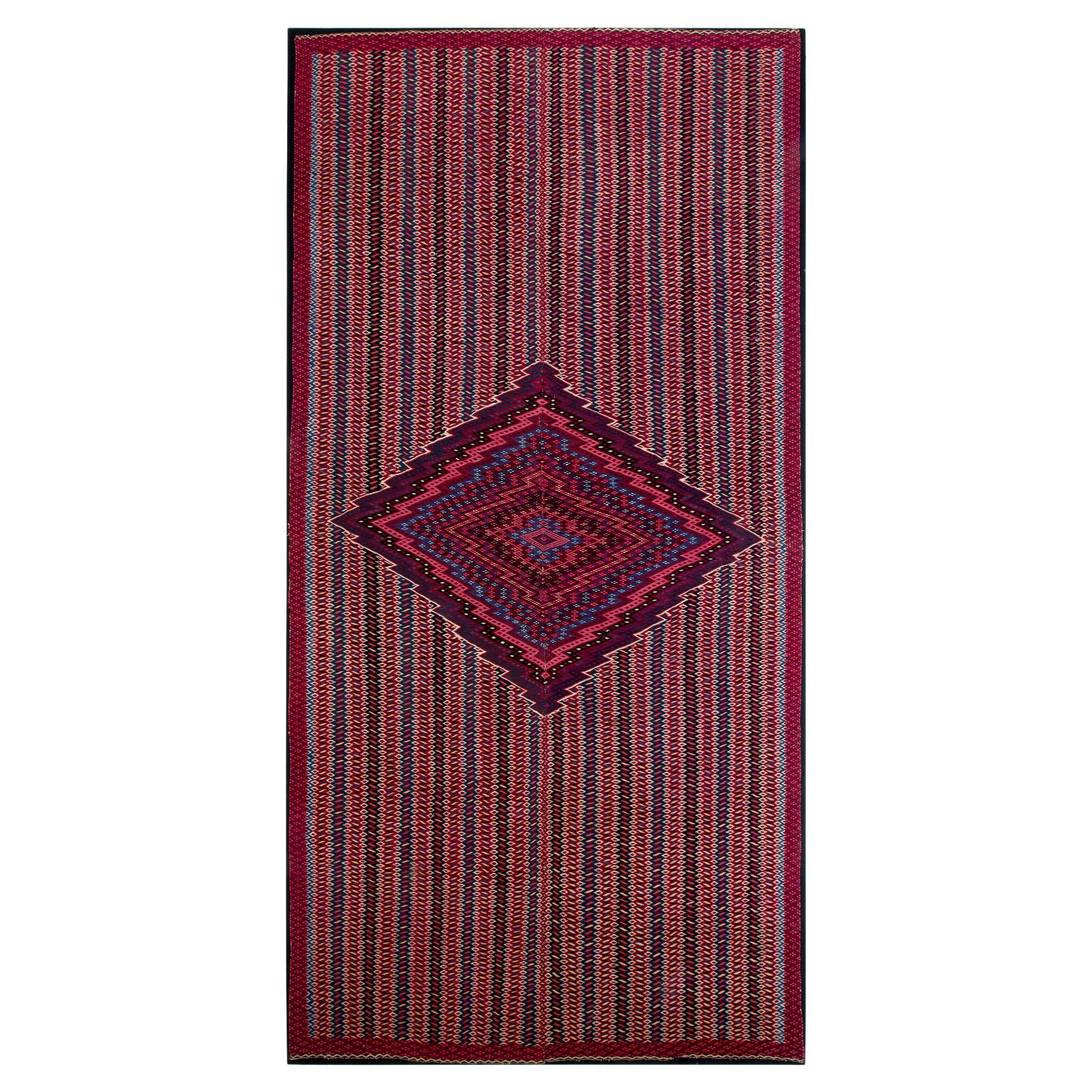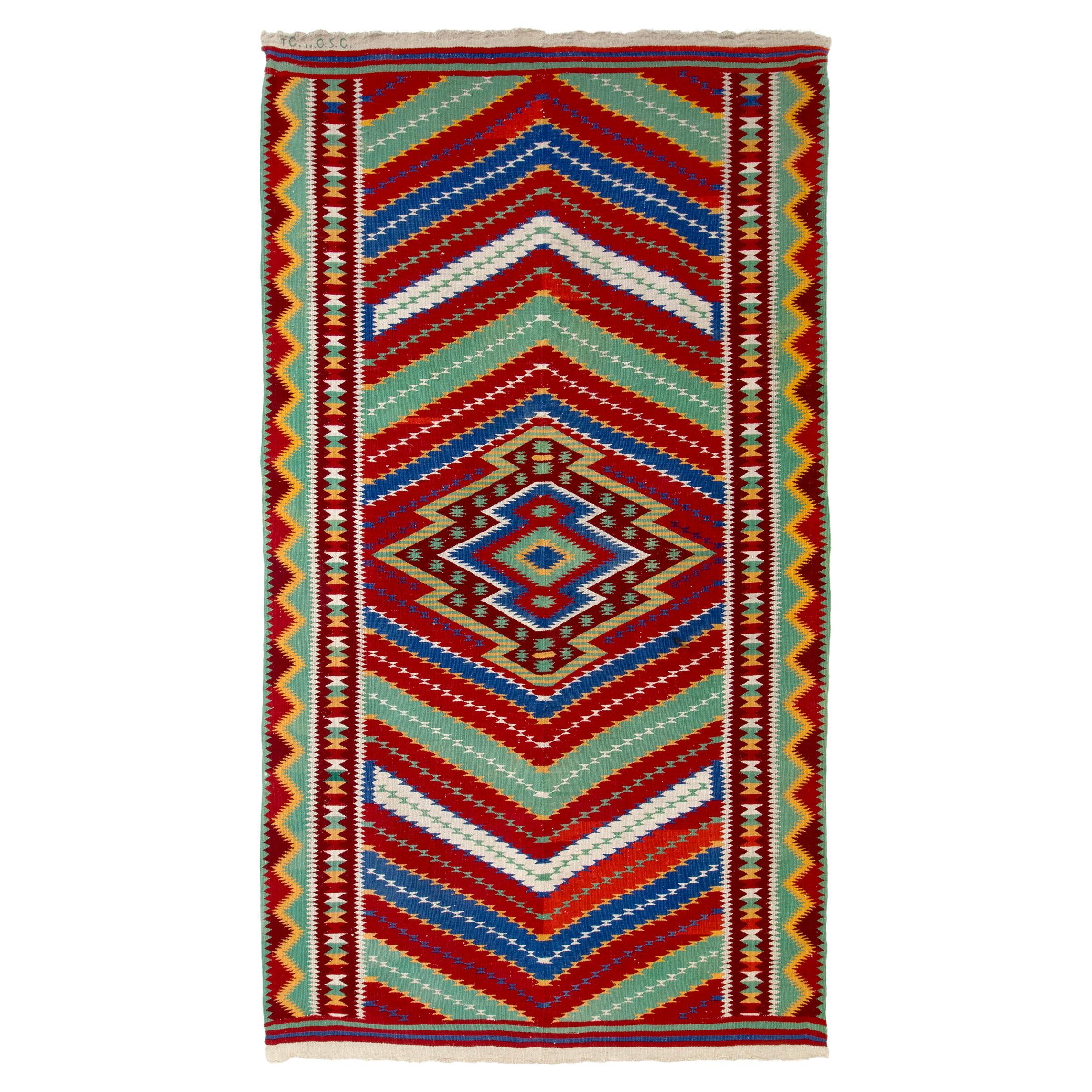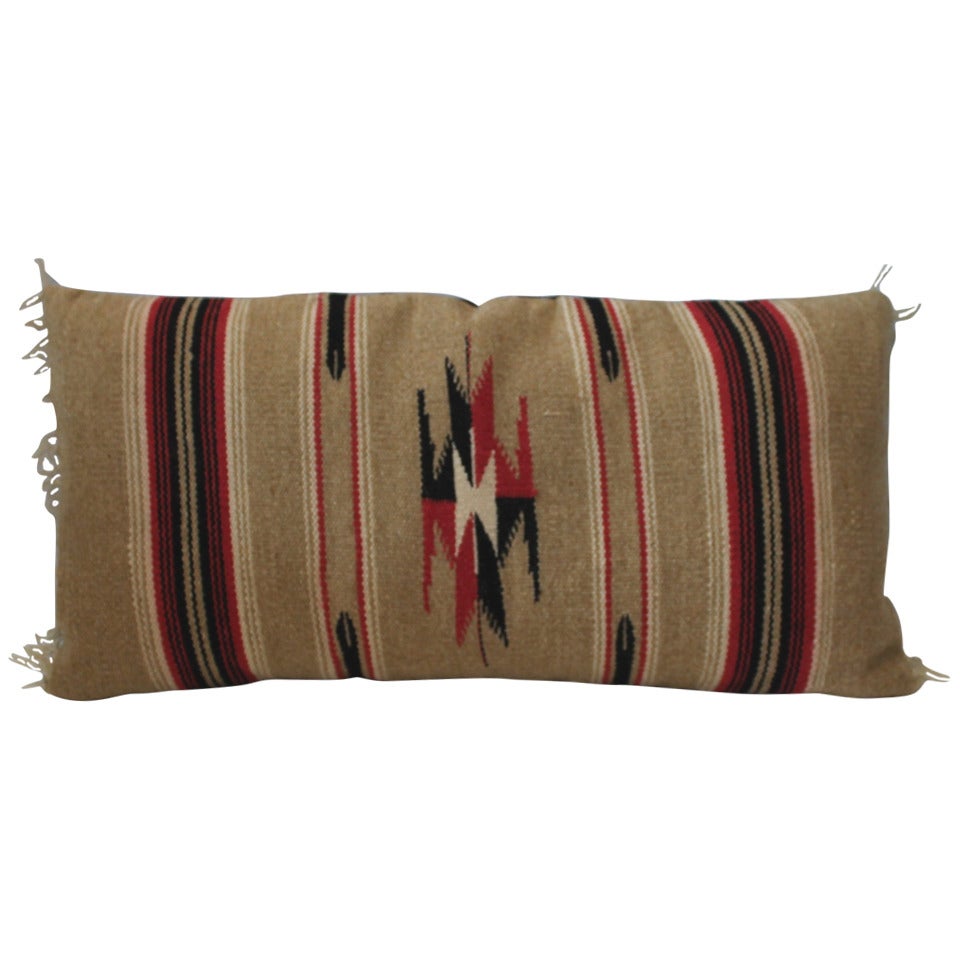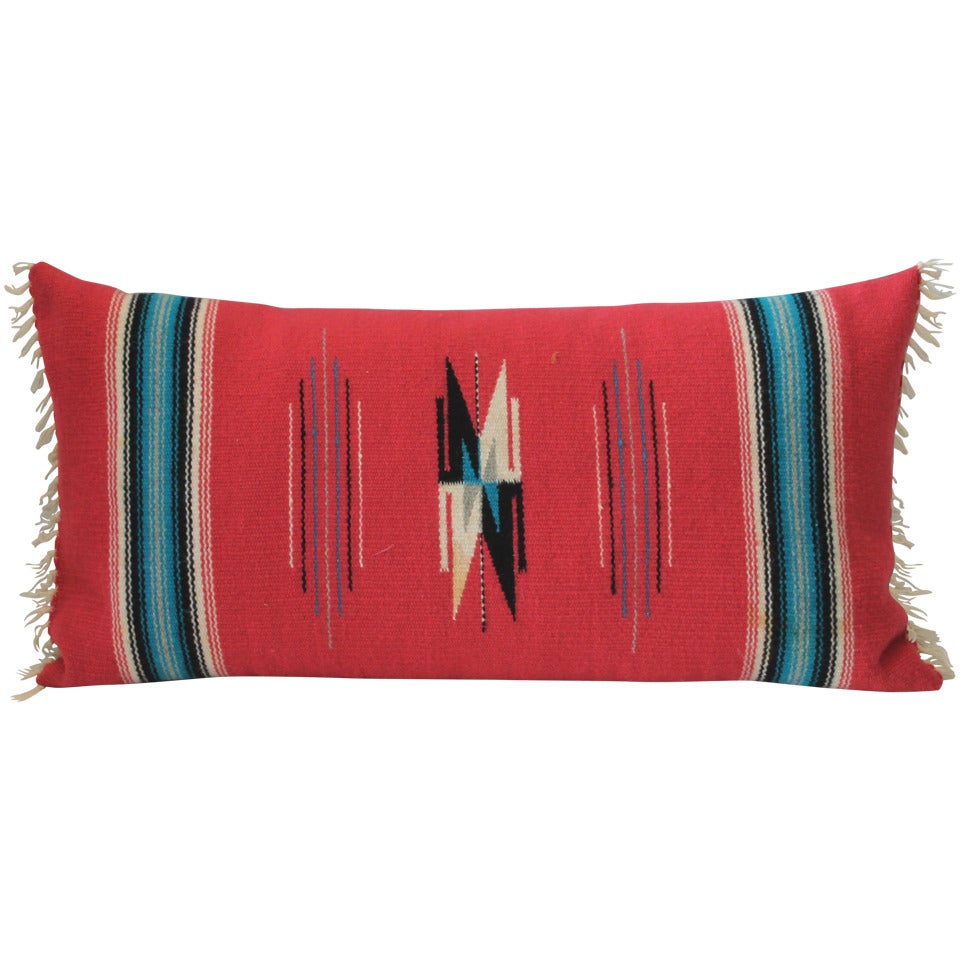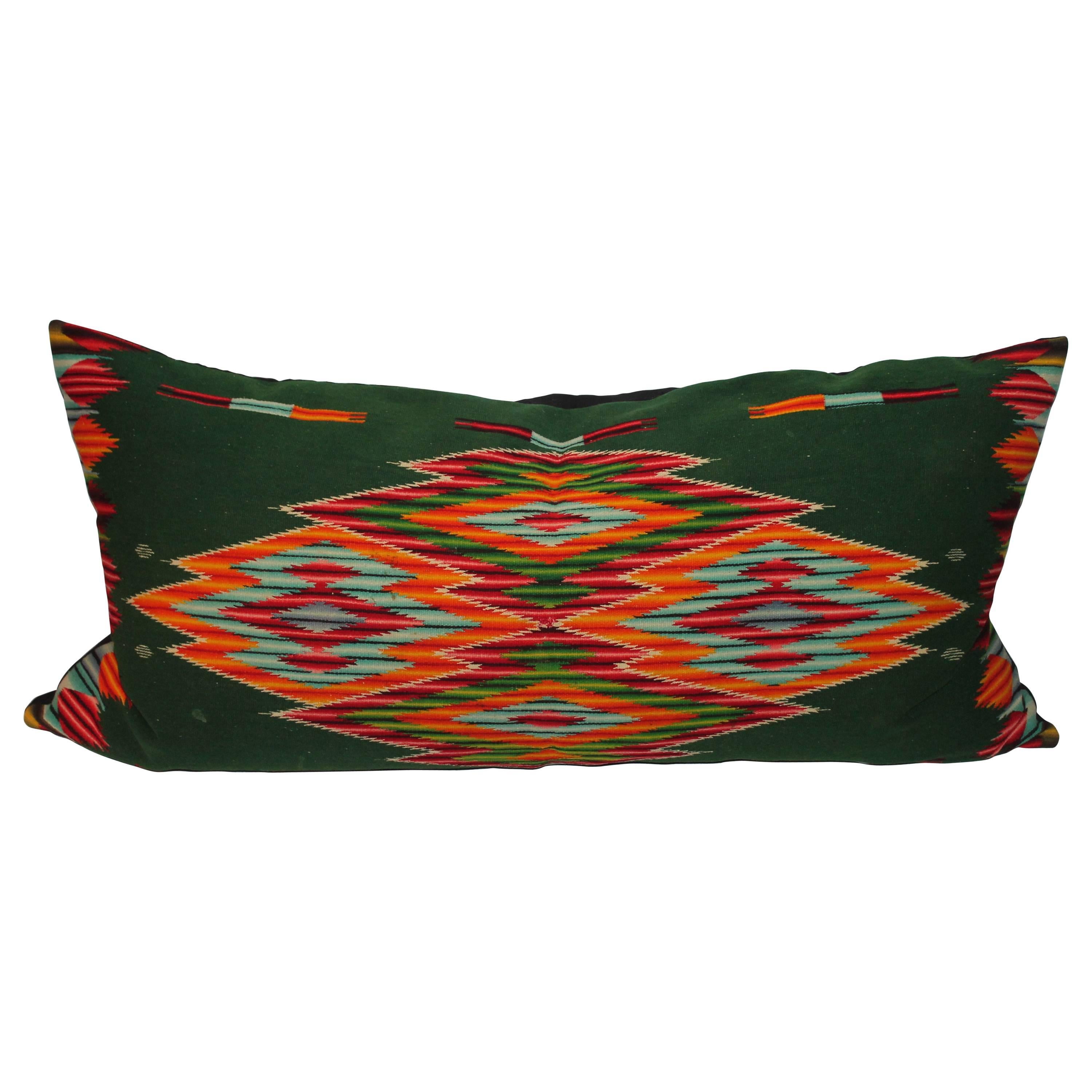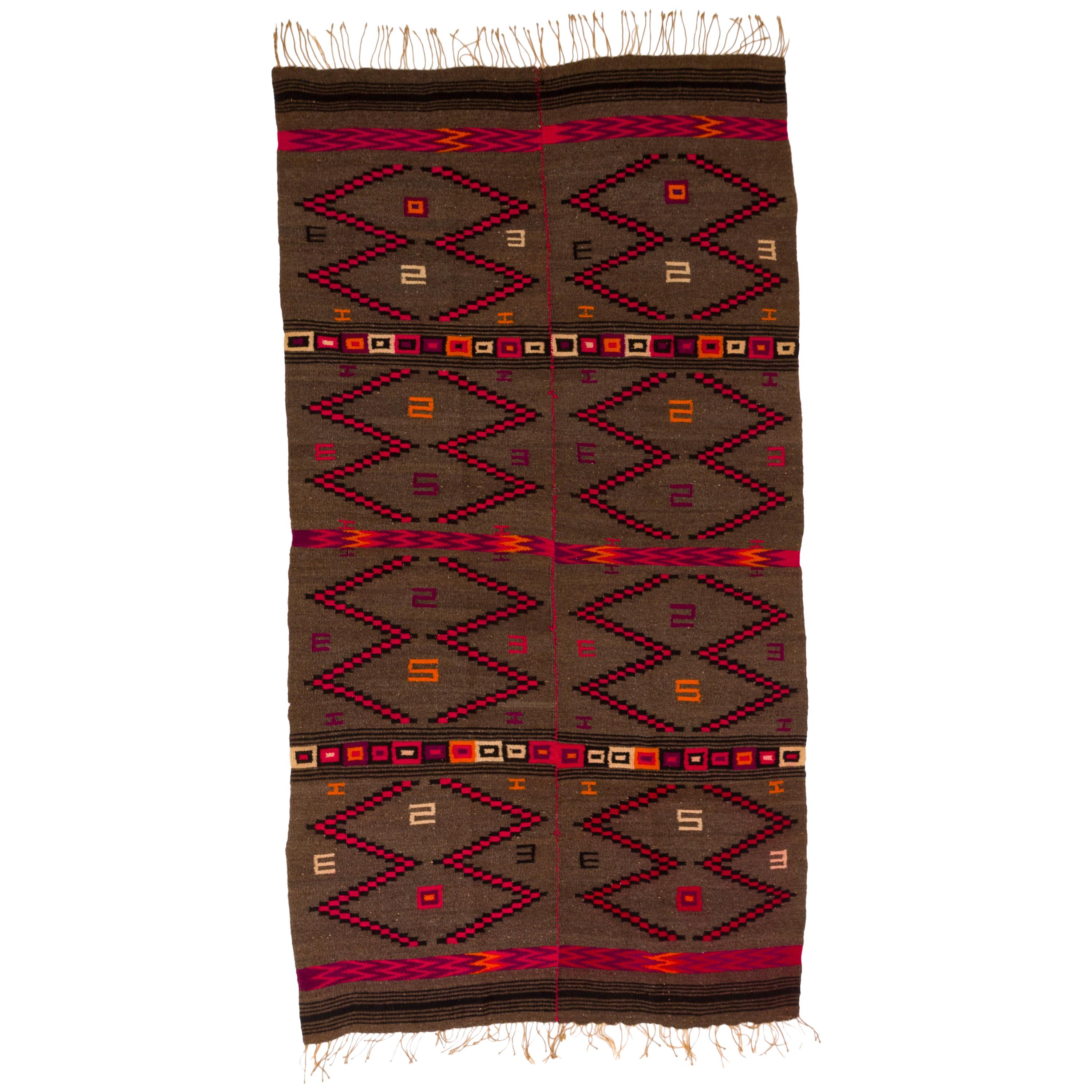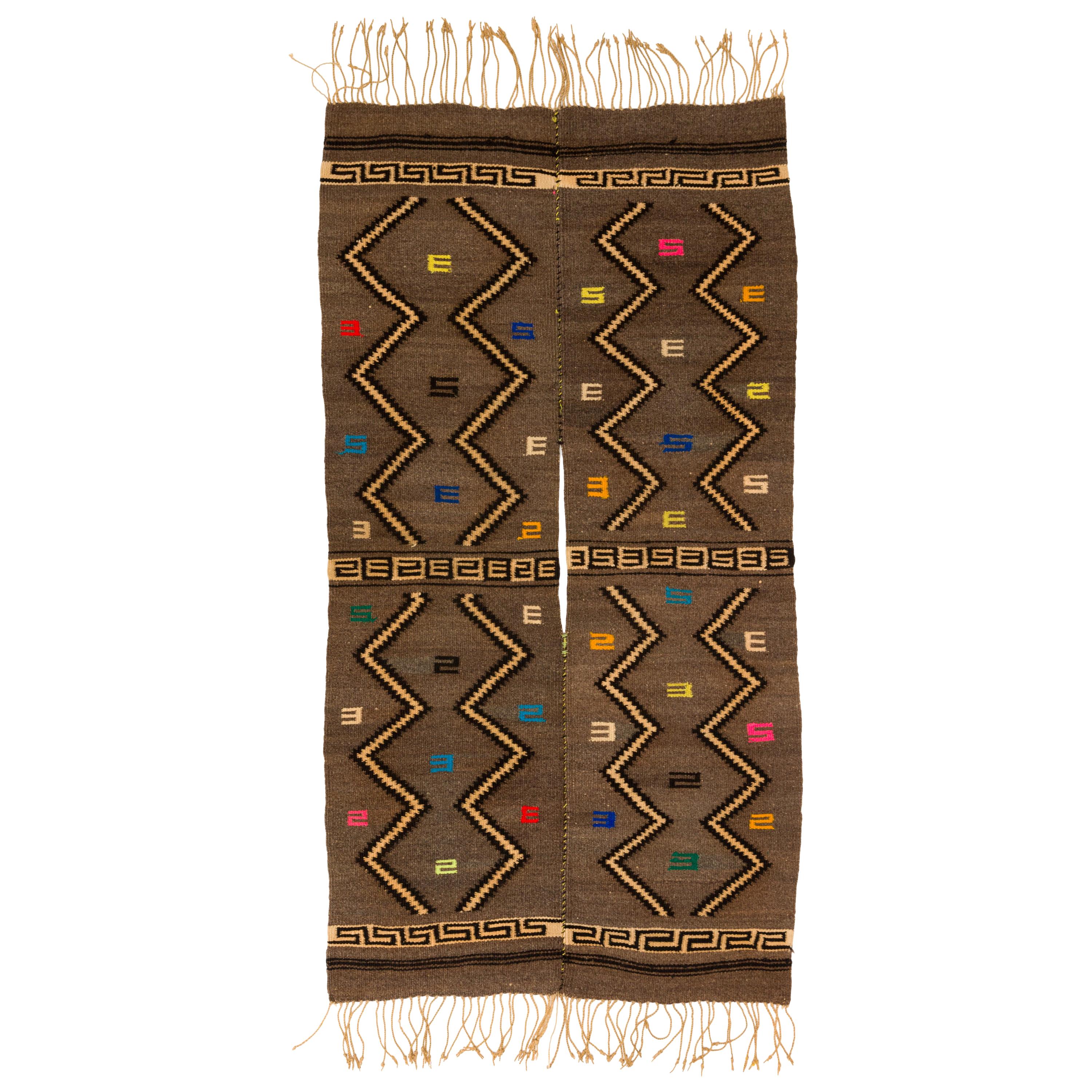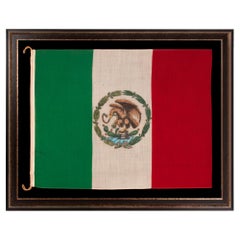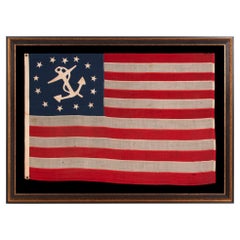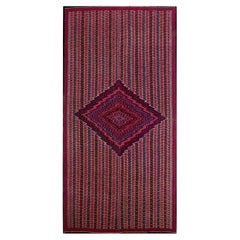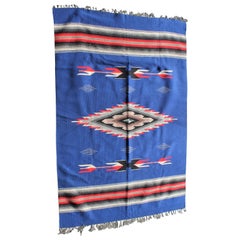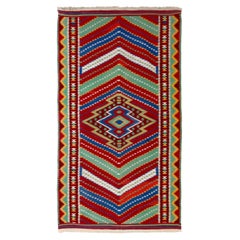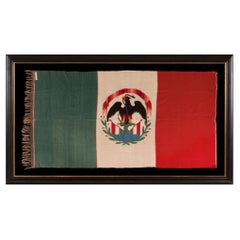
Saltillo Serape, in the Form of the Mexican National Flag, ca 1885-1910
View Similar Items
Want more images or videos?
Request additional images or videos from the seller
1 of 7
Saltillo Serape, in the Form of the Mexican National Flag, ca 1885-1910
About the Item
- Dimensions:Height: 54 in (137.16 cm)Width: 95 in (241.3 cm)Depth: 2.5 in (6.35 cm)
- Materials and Techniques:
- Place of Origin:
- Period:
- Date of Manufacture:1885-1910
- Condition:See Item Description.
- Seller Location:York County, PA
- Reference Number:Seller: otx-0271stDibs: LU849729692632
About the Seller
5.0
Recognized Seller
These prestigious sellers are industry leaders and represent the highest echelon for item quality and design.
Established in 1991
1stDibs seller since 2008
61 sales on 1stDibs
Typical response time: 9 hours
More From This SellerView All
- Mexican National Flag, Hand-Panted, ca 1917-1934Located in York County, PAMEXICAN NATIONAL FLAG IN THE DESIGN USED BY REVOLUTIONARIES FROM 1917 - 1934, THE FIRST PERIOD IN WHICH THE EAGLE WAS ILLUSTRATED IN SIDE VIEW; MADE OF GABARDINE WOOL AND WOOL BUNTING, WITH RICH COLORS AND A HAND-PAINTED DEVICE, USED IN THE LATTER YEARS OF THE ERA OF PONCHO VILLA (b. 1878, d. 1923) Flag of Mexico, in the design adopted in 1917 by the revolutionary government, in use until a re-design of the seal took place in 1934. This covered part of the principal era of Francisco "Poncho" Villa. The field is comprised of the expected vertical bars of green, white, and red, with the charge on the white bar. This is the first period in which the device consisted of an eagle in side view, instead of with breast forward. Perched on a rock that protrudes from a body of water, with prickly pear cactus growing outward and upward from each side, the war-like bird grips a rattlesnake in its proper right talon and beak. The image is cradled within an open wreath of oak and laurel branches, tied with a bow at their juncture, in the bottom center. The bow is striped with the national colors. One year before this flag was accepted, in 1916, U.S. President Woodrow Wilson sent General John Pershing to capture Poncho Villa, whose loyalty shifted as he attempted to gain power. The chase ended abruptly in 1917, when the U.S. entered WWI (U.S. involvement 1917-1918). It was in this year that the U.S. recognized the Carranza government of Mexican Revolutionaries...Category
Mid-20th Century Mexican Political and Patriotic Memorabilia
MaterialsCotton
Price Upon Request - Native American Beadwork Gauntlets with an Chief, ca 1880-90Located in York County, PANative American beadwork gauntlets with Indian Chiefs in feathered headdresses, probably souix, Ca 1880-90 Native American beadwork gauntlet...Category
Antique Late 19th Century American Native American Objects
MaterialsLeather
- Outstanding 13 Star Hand-sewn American Private Yacht Flag, ca 1865-1885Located in York County, PAOUTSTANDING, 13 STAR, ANTIQUE AMERICAN PRIVATE YACHT ENSIGN WITH GREAT FOLK QUALITIES THAT INCLUDE AN UNUSUALLY WIDE ANCHOR AND A DECIDEDLY LOPSIDED RING OF 13 STARS; MADE DURING THE 2ND HALF OF THE 19TH CENTURY; ITS DEVICE HAND-SEWN AND SINGLE-APPLIQUÉD Private yacht ensigns were approved American signals for maritime use that allowed pleasure boats to bypass customs. Though the legislation that approved them was adopted prior to 1850, almost all such flags that one will encounter were sewn by electric machine and made during the 20th century. The unusual gems among surviving examples are those that are earlier and include hand-sewn elements. Even more rare are a select few with atypical graphics. Barely any fall into both of these categories at once. Take note of the anchor on this particular flag, wide a long horizontal crossbar (stock) that contributes to uncommonly wide stance. Set within a ring of stars that is decidedly lopsided, the result is as bold as it is endearingly whimsical—two of the best qualities in American folk art, a category in which this particular example can be filed. While I have owned 13 star private yacht flags that have displayed star and canted anchor devices that were somewhat larger and/or bolder than typical, I cannot recall any that were so graphically intriguing as this one. Brief History of Private Yacht Ensigns: The medallion configuration, 13-star, 13-stripe flag, with a canted center anchor was entered into official use in 1848, following an act of Congress, that made it the official signal for U.S. pleasure sailing vessels. The need for such a flag arose with the popularity of boating as a pastime for well-to-do Americans, and as a competitive sport, in addition to its longstanding utilitarian role as a vehicle of trade. In early America, all boats were subject to customs searches at every port. Without modern income tax, the federal government derived its revenues mostly from tariffs, so an accounting of foreign goods on ships was a critical venture. As yachting for pleasure became more prevalent, however, more and more time was spent searching boats that had no such inventory, wasting time for both customs officials and wealthy ship owners. John Cox Stevens, a former president of the Jockey Club and future founder of the Union League Club, became the New York Yacht Club’s Commodore upon its founding in 1845. In 1847 he approached the secretary of the treasury and suggested that something be done to streamline the customs process for non-trade vessels. In 1848, legislation passed Congress requiring registration of these boats, which could then fly the “American Yachting Signal” to bypass customs. This remained on the books until the 1980’s, when the 1848 legislation was revoked, but the use of flags in this design for decorative function continues to this day. 13 star flags have been flown throughout our nation’s history for a variety of purposes. In addition to their use on private yachts, they were hoisted at patriotic events, including Lafayette’s final visit in 1824-25, the celebration of the nation’s centennial in 1876, and the sesquicentennial in 1926. They were displayed during the Civil War, to reference past struggles for American liberty and victory over oppression, and were used by 19th century politicians while campaigning for the same reason. The U.S. Navy used the 13 star count on small boats until 1916, because it was easier to discern fewer stars at a distance on a small flag. Commercial flag-makers mirrored this practice and some private ships flew 13 star flags during the same period as the Navy. Construction: The stars and anchor are made of cotton, hand-sewn, and single-appliquéd. This means that they were applied to one side of the canton, then the blue fabric was cut from behind each star, folded over, and under-hemmed, so that one star could be viewed on both sides of the flag. I always find single-appliquéd stars more interesting, not only because they are evidence of a more difficult level of seam-work and stitching, but also because they are more visually intriguing. The two visible rows of hand-stitching emphasize their hand-sewn construction. For these reasons, single-appliquéd stars often appeal to connoisseurs of early American textiles...Category
Antique Mid-19th Century American Political and Patriotic Memorabilia
MaterialsWool
Price Upon Request - Elaborate Sailor Souvenir of Washington Crossing the Delaware, ca 1885-1912Located in York County, PAElaborate sailor’s souvenir embroidery from the orient with a beautiful hand-painted image of Washington crossing the Delaware, surrounded by a large eagle, federal shield, crossed flags, a cannon, cannonballs, and anchor, circa 1885-1910: Between roughly 1880 and 1915, American sailors visiting the orient could obtain beautiful needlework embroideries on shore, with patriotic American themes. These extraordinary works of art were acquired as mementos of a long voyage, often with the hope that they might be presented as gifts for loved ones and friends. Using silk floss, elaborately embellished with both silver and gold metallic bullion thread...Category
Antique Late 19th Century Asian Political and Patriotic Memorabilia
MaterialsSilk
- Angora Chaps with Beautiful Tooled Leather, Made by John Clark SaddleryLocated in York County, PAWooly, angora chaps with beautifully tooled leather, made by the John Clark saddlery company of Portland, Oregon, signed, circa 1873-1929. Wooly chaps ...Category
Antique Late 19th Century American Native American Objects
MaterialsLeather
- 13 Star Antique American Flag in the Betsy Ross Pattern, ca 1861-1865Located in York County, PA13 star antique American flag in the Betsy Ross pattern, one of just three examples that I have encountered that pre-date the 1890’s; an extraordinary find, civil war period (1861-1865) or just after, extremely large among its counterparts of all periods in this design: Exceptional, early, American national flag, with 13 stars arranged in the circular wreath pattern most often attributed to Betsy Ross. Since there was no official configuration for the stars of the American flag until 1912, when our nation received its 47th and 48th states, the design, before that time, was left to the whims of the maker. This led to an almost unimaginable spectrum of star arrangements on the American flag during the 18th and 19th centuries. Even within the 13 star count, alone, there are at least 80 known patterns—more than the average person would even think possible. 13 star flags have been made throughout American history, from at least June 14th, 1777, when the first Flag Act was passed by Congress, until the present. They have been continuously produced for reasons both patriotic and utilitarian. Because this was the original number of stars on the American flag, representing the 13 colonies, it was appropriate for any device made in conjunction with celebrations or notions of American independence. 13 star flags were thus displayed at patriotic events, including, but certainly not limited to, such occasions as Lafayette’s final visit, in 1825-26, the nation’s centennial in 1876, and longstanding celebrations of Independence Day. From at least 1840 onward, 13 star flags were produced for presidential campaigns, drawing a parallel between the past and present struggles for freedom, and were carried by soldiers, during the Mexican and Civil Wars, for the same purpose. Throughout history, and even today, they are boldly displayed at every presidential inauguration. 13 star flags were flown by American ships both private and federal. The U.S. Navy used 13 stars on the ensigns made for small boats, because they wished the stars to be more easily discernable at a distance. Private ships often copied Navy practice, and when commercial flag makers first began to produce flags with pieced-and-sewn construction, in small sizes, in large quantity, they frequently employed the 13 star count. Flags in the Betsy Ross design are widely admired, due to the longstanding popularity of the Ross family myth. While many Americans learned in grammar school that Betsy Ross made and designed our first flag, and that the stars appeared in a circular fashion, there is, unfortunately, no way to prove the claim. No colonial examples have survived with this pattern of stars. In fact, while arranging the stars in a single circle seems quite logical, among the various choices that might come to mind, early American flags with this star pattern are curiously absent. One of the interesting misconceptions about 13 star flags is that the Betsy Ross pattern, even if not the original design, must have been common in early America. Logic would suggest this, given the frequency with which it appears in modern times, but this isn’t actually the case. In fact, the pattern is seldom encountered anywhere until much later. In more than 30 years of buying and selling early Americana, and over 20 years of extensive focus on the American flag specifically, through aggressively buying, researching, evaluating, restoring, and curating exhibitions, I have thus far encountered just three examples of Betsy Ross pattern flags that I can confidently date prior to the 1890's. No one knows what the first flag looked like. While there is no precise reason that the Betsy Ross design could not have been the first, one of the best arguments against it, is illustrated by the simple fact that so many 13 star flags exist without it. If the Ross configuration was the original, it stands to reason that the pattern would have been reproduced with at least some degree of frequency. Research conducted by the National Museum of American History notes that the story of Betsy Ross making the very first American flag for General George Washington, in the company of George Ross and Robert Morris, entered into American consciousness about the time of the 1876 centennial. The tale was immensely popular among an American public eager for stories about the Revolution and its heroes. The first documentation of it appeared shortly beforehand, in 1870, in a paper written by Betsy’s grandson, William Canby, for the Pennsylvania Historical Society. At the time, Canby made no mention of how the flag was designed, save for the fact that it had 5-pointed stars, per his grandmother’s suggestion. Because no earlier documentation supports the story, most flag scholars feel it was a grand hoax, fabricated by Canby for his own interests. Nothing survives in the collective writings of the three men, for example, nor in records of their words and deeds, which are fairly extensive. As with most things, reality is perhaps somewhere in the middle ground, with some of the details based on fact and some on fiction, made up, misinterpreted, or imagined from family accounts. The first time that a star configuration gets attached to the Ross story appears to have occurred during the last decade of the 19th century. In 1892, Charles Weisgerber painted a nine-by-twelve-foot rendition of the fabled meeting between Betsy and George Washington, in which there is a flag with a circular wreath. Shortly afterwards, in 1898, Betsy’s granddaughter and great-granddaughter began to make flags in the East Wing of Independence Hall in Philadelphia, selling them to tourists while disseminating the family folk tale. In that same year, Weisgerber and a “group of concerned citizens” sought to preserve Betsy’s former Philadelphia residence at 239 Arch Street, where she lived at the time the flag would have been sewed. Weisgerber moved his family into the house and immediately opened to the public the room in which Betsy was said to have worked her magic. Ten-cent memberships were sold to fund renovations and donors received a small calendar, to which a cotton 13 star Betsy Ross pattern parade flag was affixed. The effects of these events caused the Ross legend to stick and the story, with the corresponding flag design, has appeared ever since in more places than one could ever hope to count. The stars of this particular flag are made of cotton, hand-sewn, and double-appliquéd (applied to both sides). The canton and stripes of the flag are made of wool bunting that has been pieced and joined with treadle stitching. There is a sailcloth canvas binding along the hoist, with two brass grommets, one each at the extreme top and bottom. Along this, on the obverse, near the bottom, are two, unusual characters, embroidered with brown thread. These may be letter “I’s,” possibly forming a the Roman Numeral “II.” They are followed by an inscription, in blue ink, that appears to read “A. N. Smith.” The first character is stylized, and may alternatively be a “D,” “H,” or perhaps a “J.” Note how the binding is extended beyond the top and bottom-most points. Though quite unusual, this is sometimes encountered in early examples. The folding of the wool bunting back onto itself, with the binding stitched so that part of the fold is exposed, tends to be an early characteristic. Common in Civil war flags...Category
Antique 1860s American Political and Patriotic Memorabilia
MaterialsCotton
Price Upon Request
You May Also Like
- Antique 1850s Mesoamerican Saltillo Serape Transitional Mounted TextileLocated in Denver, COMesoamerican Saltillo Serape transitional textile from 1850, made of wool with natural dyes in red, pink, blue, white and black. Presented securely mou...Category
Antique Mid-19th Century American Native American Native American Objects
MaterialsWool
- Mexican / American Serape in Unusual ColorsLocated in Los Angeles, CAThis fine Mexican / American serape weaving is in pristine condition and wonderful unusual colors. The fringe is very good too.Category
Mid-20th Century American Adirondack Quilts and Blankets
MaterialsWool
$575 Sale Price35% Off - Rio Grande Serape, 1880s Saltillo, Germantown Yarns Diamond Pattern, Red GreenLocated in Denver, COAntique circa 1880 Rio Grande Saltillo Sarape, hand woven of Germantown yarns in colors of red, green, golden yellow, blue, and white in a diamond pattern, fringed at either end. Ready to hang on the wall with custom velcro mount (fully removable). The Rio Grande style of serape developed in the Southwestern United States in present day New Mexico and was inspired by Mexican Saltillo Serapes...Category
Antique Late 19th Century American Spanish Colonial Native American Objects
MaterialsWool, Cotton
- Mexican-American Serape Bolster PillowLocated in Los Angeles, CAThis neutral tan background Indian weaving is in wonderful condition and made a great statement as a bolster pillow. The backing is in tan cotton linen backing. Insert is down and fe...Category
Vintage 1930s American Native American Objects
MaterialsWool
$475 Sale Price46% Off - Mexican Red Serape Bolster PillowLocated in Los Angeles, CAThis vibrant red ground Mexican or American Indian weaving has bold colors and in great condition. The backing is in a black cotton linen and down and feather fill.Category
20th Century American Adirondack Native American Objects
MaterialsWool
$595 Sale Price37% Off - Monumental Mexican Serape Weaving Bolster PillowLocated in Los Angeles, CAThis handwoven Mexican weaving bolster pillow has amazing colors and in fine condition. The backing is in black cotton linen. The insert is down and fe...Category
Vintage 1930s American Adirondack Native American Objects
MaterialsWool
$750 Sale Price40% Off
Recently Viewed
View AllMore Ways To Browse
Mexican Flag
Mexico Flag
Antique Mexican Textiles
Memory Folk Art
Antique Mexican Flag
Mexican Serape
Antique Furniture Sydney
S Smith And Son
Spanish Eagle
Wool Poncho Used
Antique Furniture In Sydney
Antique Frames Sydney
Salt Mill
American Folk Art Painted Children Furniture
Eagle Textiles
Sarah Williams
Antique Genealogy
Metal Cactus
